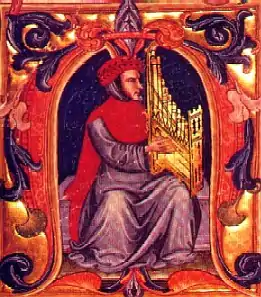Jacopo da Bologna
Jacopo da Bologna (fl. 1340 – c. 1386) was an Italian composer of the Trecento, the period sometimes known as the Italian ars nova. He was one of the first composers of this group, making him a contemporary of Gherardello da Firenze and Giovanni da Firenze. He concentrated mainly on madrigals, including both canonic (caccia-madrigal) and non-canonic types, but also composed a single example each of a caccia, lauda-ballata, and motet (Marrocco 1954, 14–16, 27–28; Fischer and d'Agostino 2001).
His setting of Non al suo amante, written about 1350, is the only known contemporaneous setting of Petrarch's poetry (Petrobelli 1975; Fischer and d'Agostino 2001).
Jacopo's ideal was "suave dolce melodia" (sweet, gentle melody) (Fischer and d'Agostino 2001). His style is marked by fully texted voice parts that never cross. The untexted passages which connect the textual lines in many of his madrigals are also noteworthy (Cuthbert 2006, 192).
He is well represented in the Squarcialupi Codex, the large collection of 14th century music long owned by the Medici family; twenty-nine compositions of his are found in that source, the principal source for music of the Italian ars nova, alongside music by Francesco Landini and others (Marrocco 1954, 6). A portrait of Jacopo is found in this manuscript, and another possible portrait is found in a north-Italian manuscript, Fulda, Landesbibliothek, Hs. D23, fol. 302 (Fischer 1973; Fischer and d'Agostino 2001). However, the identification of Jacopo as the subject of the painting in the latter source was made by a hand later than the manuscript copyist's, throwing some doubt on its reliability (Fischer 1973, 62).
In addition to his compositions, Jacopo also wrote a short theoretical treatise, Questa è l'arte del biscanto misurato (Jacopo da Bologna 1933; Marrocco 1954, 146–55), which is influenced by French notational theory (Fischer and d'Agostino 2001). He may also have been active as a poet, to judge from the autobiographical texts of the madrigals Io me sun un che, Oselleto salvazo, and Vestìse la cornachia (Fischer and d'Agostino 2001).
Selected bibliography
- Cuthbert, Michael Scott. 2006. "Trecento Fragments and Polyphony Beyond the Codex". Ph.D. diss. Cambridge: Harvard University.
- Fischer, Kurt von. 1973. "'Portraits' von Piero, Giovanni da Firenze und Jacopo da Bologna in einer Bologneser Handschrift des 14. Jahrhunderts?" Musica Disciplina 27: 61–64.
- Fischer, Kurt von. 1988. "Drei unbekannten Werke von Jacopo da Bologna und Bartolino da Padova?" In Miscelánea en homenaje a Monseñor Higinio Anglés. 2 vols. Edited by Miguel Querol, et al., 1:265–81 Barcelona: Consejo Superior de Investigaciones Cientificas, 1958-61. Reprinted in Studi musicali 17: 3–14.
- Fischer, Kurt von, and Gianluca d'Agostino. 2001. "Jacopo da Bologna". The New Grove Dictionary of Music and Musicians, edited by Stanley Sadie and John Tyrrell. London: Macmillan Publishers.
- Jacopo da Bologna. 1933. L' arte del biscanto misurato secondo el Maestro Jacopo da Bologna, edited by Johannes Wolf. Regensburg: Bosse.
- Marrocco, W. Thomas. 1954 The Music of Jacopo da Bologna. University of California Publications in Music 5. Berkeley and Los Angeles: University of California Press, 1954. (Appendix C is an English translation of Jacopo's treatise.)
- Marrocco, W. Thomas (ed.). 1967. Italian Secular Music, by Magister Piero, Giovanni da Firenze, Jacopo da Bologna. Polyphonic Music of the Fourteenth Century 6. Monaco: Éditions de l'Oiseau-Lyre.
- Nádas, John. 1985. "The Transmission of Trecento Secular Polyphony: Manuscript Production and Scribal Practices in Italy at the End of the Middle Ages". Ph.D. diss. New York: New York University.
- Petrobelli, Pierluigi. 1975. "'Un leggiadretto velo' ed altre cose petrarchesche", Rivista Italiana de Musicologia 10:32–45.
